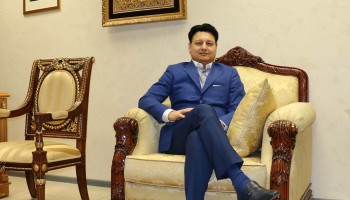Industry experts estimate that there are tens of thousands of these workers in some 2,500 kopanki or illegal pits around Ukraine, mostly in the protest-wracked Donbas region around Donetsk. Before the ouster, the numbers of pits and of workers were rising, some say with the quiet approval of authorities, many of whom are still tied to Yanukovych.
While the illegal miners work, they get little pay and work in very dangerous conditions. Meanwhile, a group of businessmen close to the former president has benefited handsomely at the miners expense.
It was nearly a year ago, in June of 2013, when Member of Parliament Oleh Medunytsia submitted a bill calling for investigation of corruption related to illegal coal mining. “It’s clear that such massive-scale legalization of illegally extracted coal cannot happen without a state component in this scheme,” the draft law reads.
He explains that in 2012, state-owned and private coal mines in Ukraine reported extracting up to 61.1 million tons of thermal coal. But the state railway company Ukrzaliznytsia transported 66.9 million tons during that time. The 5.8 million ton difference, he said, represents illegally extracted coal.
Coal miners’ trade unions estimate that the actual amount is closer to 6 to 7 million tons. Considering that the average price for coal is about $100 per ton, the annual output of illegally mined coal could be worth $700 million, according to a Nov. 22, 2012 statement by the Independent Trade Union of Ukraine and local union of Donbas (Eastern Ukrainian coal-mining area). “Recently, new pits and quarries are appearing like mushrooms in warm and rainy weather,” the joint statement reads.
Such volumes of illegally extracted coal require a steady market, which raises questions as to who is buying the massive quantities. After all, 7 million tons is 11 percent of the country’s entire annual output of thermal coal, including production from private mines.
Black Schemes Illegal pit in the vicinity of Torez, Donetsk Oblast. Worker Ruslan moves coal to the surface using primitive winch and tub.
Illegal pit in the vicinity of Torez, Donetsk Oblast. Worker Ruslan moves coal to the surface using primitive winch and tub.
Corruption in the coal market relies on the fact that the market is completely regulated with fixed prices. Mines are paid high prices but are also expensive to operate and keep safe. However, if mine managers or other businessmen can buy coal from illegal miners, who sell at about a fifth of the official price, they can sell it on at the official rate to state coal processors, and make a lot of money.
To sell coal legally, it needs to pass through a coal enrichment plant where raw coal is purified and sorted into grades for shipment to consumers. That would theoretically make scrutiny by authorities easy.
But that does not appear to be happening. OCCRP identified several routes by which coal dug from illegal pits is “laundered” into legal coal. The routes lead through state-owned mines, coal enrichment plants and shell companies.
The laundering of illegal coal through state facilities is not new and has existed at least as far back as the tenure of Yulia Tymoshenko, prime minister from 2007-2010.
In December of 2008, Mykhaylo Volynets, head of the Independent Coalminers Union of Ukraine, explained to Ostrov, a Donetsk media outlet, how illegal coal was legalized through Sverdlovantratsyt, a state-owned coal extraction company in Luhansk Oblast.
“Just within the last three months Vyhillia Ukrainy received from Sverdlovantratsyt 120,000 tons of extra coal, most likely stolen and delivered from illegal pits… This cheap coal from the pits is then sold by Vyhillya Ukrainy as if it was extracted in a state-owned mine with high extraction costs. The difference between the selling price and costs is covered by the state.”
In the proposed law to investigate the matter, Member of Parliament from Luhansk, Volodymyr Landik said that Sverdlovantratsyt continued to buy coal of uncertain origin and sold it through Vyhillya Ukrainy. In the first quarter of 2008, $22 million in illegal coal was sold. At the same time, 200 tons of Sverdlovantratsyt’s own coal was sitting in its warehouses.
Overall in the first five months 2008 over 2.8 million tons of illegal coal got to electric power stations, Parliament member and head of Coal Miners Trade Union Viktor Turmanov said.
In March 2010,Parliament also considered investigating, but never did.
But shortly after Yanukovych came to power, his government, led by Mykola Azarov, cancelled Vyhillia Ukrainy’s monopoly over supplying coal to state-owned power stations (http://www.president.gov.ua/docs/gr2.pdf). This made room for businessmen to profit from illegal coal
Power as the recipe of business success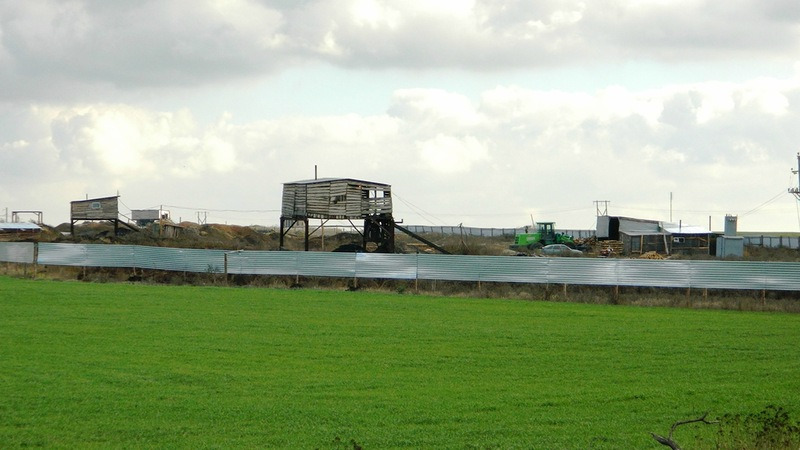 Illegal pits in the fields near village Stozhkovskoe, Shakhtarsk district, Donetsk Oblast. Photo shows the fenced in plot, in the middle of a field of winter wheat.
Illegal pits in the fields near village Stozhkovskoe, Shakhtarsk district, Donetsk Oblast. Photo shows the fenced in plot, in the middle of a field of winter wheat.
A series of circumstantial links indicate Yanukovych was directly connected to a network of businessmen who took over the trade in illegal coal. At the center was the Komsomolska Coal Enrichment Plant.
In the late 1990’s, Eduard Prutnik, Yanukovych’s advisor during his first term as prime minister, set up an association of financial, industrial and trade companies called Donbas Financial Transaction Center (DFTC). At the time of its founding, Prutnik was the director and founder of one of the member companies of the association. DFTC would gain control of the Komsomolska Coal Enrichment Plant. In 2009, a limited liability company with the same name as the association, DFTC, was formed with Prutnik as an owner. The limited liability company took over the association and gained 75 percent ownership of the enrichment plant.
Yanukovych and his family members were never directly listed among the shareholders of DFTC, but they are intricately linked into the company’s ownership structure.
For example, one of the owners of DFTC is businessman Oleksandr Yurchenko through his company SPS-Group and other companies. Yurchenko has many close business ties with the prime minister and his party.
Between 2007 and 2009, Yurchenko was a co-owner of the Zoryany movie theater that the president’s Party of Regions used for all its public events during elections. Later, he co-founded the charity foundation Vidrodzhennia Ukrainy – a tenant of the land plot in the Mezhyhiria complex where Yanukovych had built his house.
There are other links. The contact phone number of Komsomolska belongs to Andriy Fedoruk, the former manager of MAKO Holding, a company owned the former president’s son Oleksandr Yanukovych according to the state database smida.gov.ua and the Ministry of Justice’s database of private entrepreneurs.
Fedoruk, a member of Donetsk Oblast Council who headed it till March, 2014,, met Yanukovych during his work for DFTC LLC. After that he was offered a job at MAKO Holding. In an interview he spoke about getting to know the younger Yanukovych. “We met sometime during the end of work at DFTC… Afterwards, I got an offer to work at MAKO.”
DFTC LLC, meanwhile, is owned by Sarone Holdings, an offshore registered in the British Virgin Islands. In late 2011, the head of DFTC LLC, Vitaly Belyakov, gave a rare interview in which he denied dealing in illegal coal. He did note that tracing the legality of coal sometimes is impossible.
“We don’t work with them (illegal pits) out of principle. We only deal with coal with legitimate history. The other thing is that we can’t always trace if the coal that got delivered to us was extracted in a legal mine, or it comes from such (a) mine only on paper,” said Belyakov.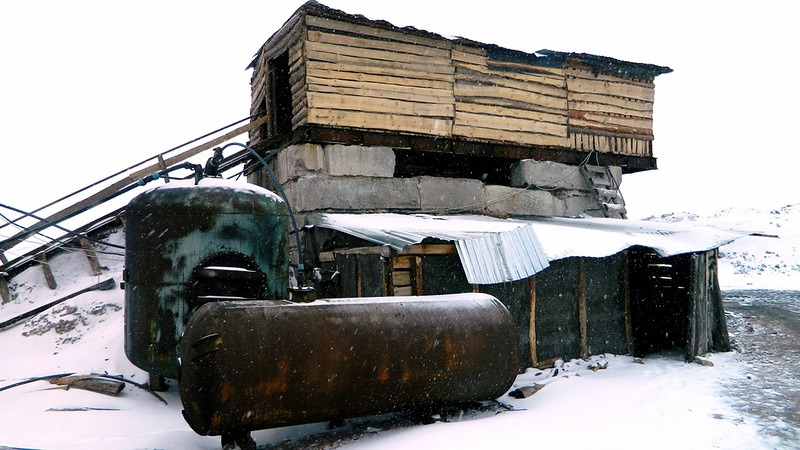 Exterior of illegal pit in Shakhtarsk district, Donetsk Oblast, resembling coal mine design of the 1950's.
Exterior of illegal pit in Shakhtarsk district, Donetsk Oblast, resembling coal mine design of the 1950's.
At the same time, Ihor Abazov, a journalist from Torez, Donetsk Oblast, who has studied illegal coal, explains: “DFTC actively works on the illegal coal market of Donbas – since 2010 no one extracting coal illegally has the right to sell large batches of coal anywhere else, except at DFTC collection points. The financial deal is as follows: $63 per ton and no negotiations!” Otherwise, Abazov said, the illegal pits would be destroyed, as the coal extracted from them becomes impossible to sell.
In April of 2011, DFTC LLC won state procurement tenders worth more than $120 million to supply coal to Vuhillya Ukrainy. In his interview, Belyakov confirms that DFTC LLC did not extract coal on its own. “Instead for many years we had agreements with coal miners, then enriched the coal and then sent it to consumers.”
In the summer of 2012, DFTC LLC became the majority owner of five coal enrichment plants: Uzlovskaya, Chervona Zirka, Komsomolska, Ukraina and Rossiya it earlier leased from the state. The legislation which banned private companies from gaining control of state enterprises they lease was amended shortly before, in March, with the support of President Yanukovych to allow such deals.
Milking
State-owned mines are key to the sale of illegal coal because they are entitled to state subsidies for coal they extract. In 2012 such subsidies totaled $1.6 billion.
Volynets says illegal coal can be bought for between $6.25 and $12.5 per ton, so coal mines buy extra, illegal coal so they can benefit from the subsidies. Typically, they pay about $50 per ton; after enrichment, it is sold for $62 per ton, and then to industry and the public at $175. Of this sale price, subsidies from the state account for $113 of the sale price. Given the amount of illegal coal entering the market, that means $678 million in paid out in subsidies for illegal coal.
This hefty subsidy is in effect siphoned from state mines into private pockets, as the mines claim to be producing more coal than they actually do produce. For example, state-owned enterprise Selidovvuhillya in 2012 kept exceeding its planned monthly output by 20-30 percent. In comparison, that year the total coal extraction in Ukraine rose by less than 5 percent.
A second money-making maneuver involves people connected to ex-President Yanukovych’s circle creating companies to sell mining equipment to state-owned enterprises.
In early 2012, three LLC’s with the same names as the coal mines that Selidovvuhillya owns showed up in Ukraine’s company registry.
The newly founded firms then started winning procurement tenders to supply mining equipment to their state-owned namesakes. For example, in April, LLC Coal Mine 1/3 Novohrodivska got a total of $5.7 million contracts to supply equipment to the eponymous coal mine. LLC Rossiya, in its turn, got $1.4 million worth of contracts in May.
A public procurement watch-dog organization, Nashi Groshi, calculated that altogether, in 2012 these twin companies alone won nearly $96 million in procurement deals granted by state-owned coal mines.
In the case of the LLCs 1/3 Novohrodivska and Shakhta Rosiya, the founder of the company supplying equipment to state mining companies is LLC Palyvno-Energetychy Kapital. Its owner is Oleksandr Sichinava, who until the end of 2011 headed the supervisory board of Vseukrainsky Bank Rozvytky, a bank 100 percent owned by Oleksandr Yanukovych.
Medunytsia’s draft law to investigate corruption surrounding the illegal coal industry states that in 2012, 4.8 million tons of illegal coal was supplied to state-owned thermal power stations, while 1 million tons was exported.
In 2012 MAKO Holding, a business owned by Oleksandr Yanukovych, started exporting Ukrainian anthracite through the Swiss-registered daughter company Mako Trading SA. That year MAKO exported nearly 200,000 according to Forbes. Perhaps coincidentally anthracite is extracted in the vicinity of the towns of Shakhtarsk, Snizhne and Torez – places with the highest concentration of illegal pits in the country.
Incapable or unwilling?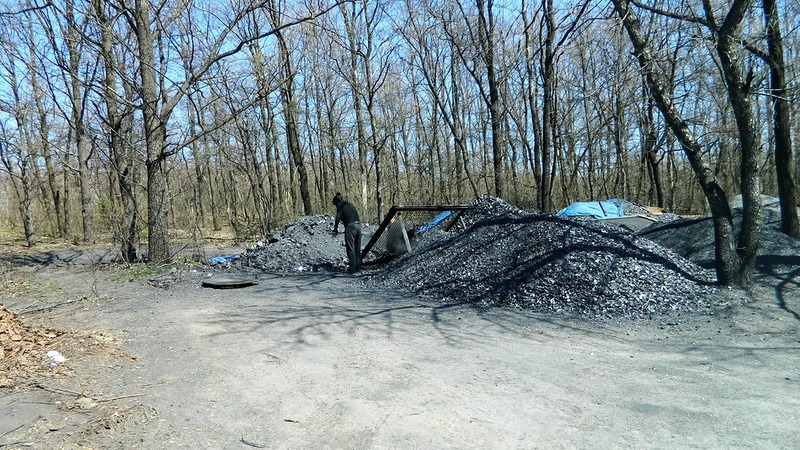 The storage area in the forest near Coal Mine 8 village in the town of Snezhnoe, where illegal coal is sorted out acording to quality.
The storage area in the forest near Coal Mine 8 village in the town of Snezhnoe, where illegal coal is sorted out acording to quality.
In February of 2013 ex-President Yanukovych commented on illegal coal-mining in a televised talk with voters about the results of his three years in the office.
“Unfortunately, this is not a problem of one day,” he said. “Because every one of these people (coal-miners working at illegal pits) has families, children who want to eat. These people don’t know how to do anything else; moreover, there is no other work in these areas.”
He did not mention one thing: as the illegal pits began appearing, pits in legal state coalmines were being shut. Yanukovych was governor of Donetsk Oblast from 1997-2002 during a time of multiple closures.
While he talks with sympathy for miners in illegal pits, Yanukovych never mentioned the legal miners who stand to lose their jobs because of illegal coal.
On March 16, 400 local coal miners from Dymytrov in Donetsk Oblast held a rally to protest the dire state of things at the mines of the state enterprise Krasnoarmiyskvuhillya, where they work.
“Since July 2012, we’ve never shipped our full loads,” says Oleksandr Abramov, head of local coal miners’ trade union. “In January, out of 2,500 tons (extracted) we shipped only 1,500 tons, in February – just 900 tons. Miners go into the pit and don’t know if they’ll be working… Dymytrov miners’ coal has become excess. Nobody buys it and it gets piled up in the warehouses.”
Similar problems can be seen at many of the 102 state-owned coal-mining enterprises. Miners are placed on unpaid leave and their salaries are being delayed. And miners openly name illegal coal as the root of their problems.
Even the official trade union, which have often supports government, had to acknowledge the severity of the problem. “The work of kopanki unbalances the Ukrainian coal industry because of the problem of extra coal on the market from illegal extraction,” said Valeriy Mamchenko, deputy head of the Coal Industry Workers of Ukraine Union.
Dark Pits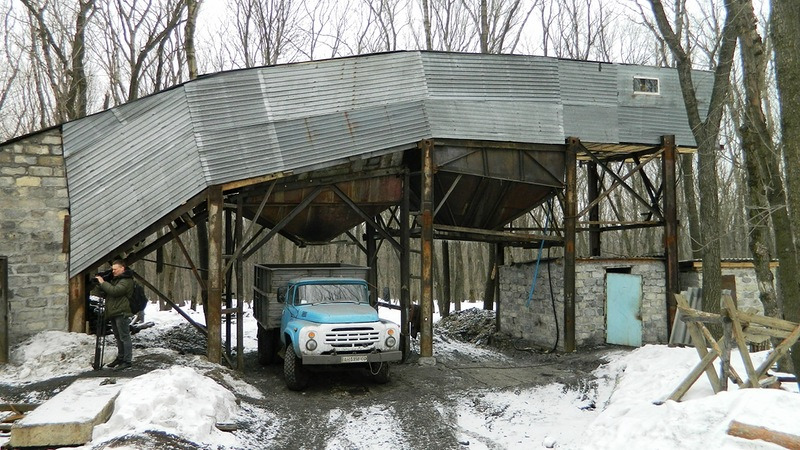 Large illegal pit in the forest near the town of Snezhnoe. The coal is loaded onto a track.
Large illegal pit in the forest near the town of Snezhnoe. The coal is loaded onto a track.
Illegal pits also lack elementary safety measures and social security. Only very rarely do the criminal investigations into their deaths end up with prosecution of the real owners.
On Feb. 29, 2012, a methane blast killed six people at an illegal coal mine near Yenakieve in Donetsk Oblast. Six miners had been working in the pit, with one more operating a hoist on the surface.
Tetyana Miniaylo, whose son died in the accident, said that for two days after the blast “nobody was doing anything.”
“I was trying to get an answer why they [the rescue service] weren’t doing anything. They told me they waited to get paid to start rescue work,” says Miniaylo. She is sure that only the involvement of mass media pushed the authorities to start moving.
“I told the local authorities, if it were not for the journalists you’d just bury that illegal pit, turning it into a mass grave,” she says.
The deaths in Yenakieve illustrate how the owners of such pits rarely face justice. Instead the dead miners get blamed.
“We were told that the hoist operator has been detained and that he’s the main suspect, because he was the main boss at the pit, in charge of the people and their wages,” Miniaylo said. “And the pit’s owner is allegedly among the six dead miners. And I ask our authorities: Why was this ‘owner’ driving an obsolete Lada and you are driving Lexuses? Whose mines are these after all?”
In March, OCCRP reporters went to Snizhne to follow the trail of illegal coal. Their searches showed an absence of will by the authorities to curtail the illegal trade, as they followed one truck from the illegal pit to the railway station Sofyino-Brodska, where it was unloaded.
It would have been fairly easy for the authorities to follow the cargo route and its paperwork within the railway cargo tracking system.
RELATED STORY - Illegal coal evolution
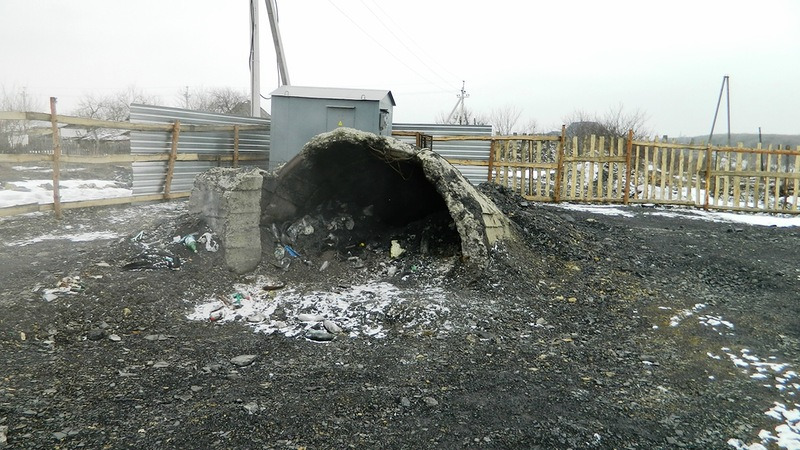 The pit set up in an abandoned shaft of Severnaya coal mine in Snezhnoe.
The pit set up in an abandoned shaft of Severnaya coal mine in Snezhnoe.
The history of illegal coal mining in the Donbas, a coal region in east Ukraine covering Donetsk and Luhansk oblasts, shows an evolution from small cottage enterprises to the country’s largest shadow industry with multi-million turnovers.
In the late 1990s, 52 state-owned mines were closed as part of the World Bank assistance program. The reasons for closure included mounting financial losses, including unpaid back wages.
The miners were left with nothing to do, no new jobs and no state subsidies to help fill the gap. So, they used the one resource at their command – a coal bed close enough to the surface in the Donbas basin that they could start extracting coal on their own.
Originally, small pits were set up out of desperation with no expectations of great riches. They were dug out with simple tools in fields, gulches, forests and, sometimes, right in the gardens in front of people’s homes. The coal was extracted manually, just enough to sell to the neighbors, and to keep their own houses warm.
In the 1990s “black gold” cost almost nothing, and therefore neither authorities nor organized crime groups paid much attention.
Illegal coal-mining is not unique to Ukraine. Self-dug pits also are widespread in the coal-mining areas of Poland, where locals work them for household needs. Yet in Ukraine, unlike in Poland, at some stage these pits came under the control of local authorities and organized crime, which turned illegal coal-mining into one of the largest shadow businesses.
In the early 2000s, all the major industrial enterprises in Ukraine were divided among oligarchic business clans and they all needed fuel. Organized crime groups began to realize there was money to be had in coal.
The criminal groups brought money and modern equipment to pits that had been using obsolete equipment. They bought up pits then supplied them with hoists, electric engines, compressors, excavators and dump trucks. Illegal miners got access to deeper layers and pillars of coal. In some towns, the output of illegal mines exceeded that of their state-owned counterparts.






